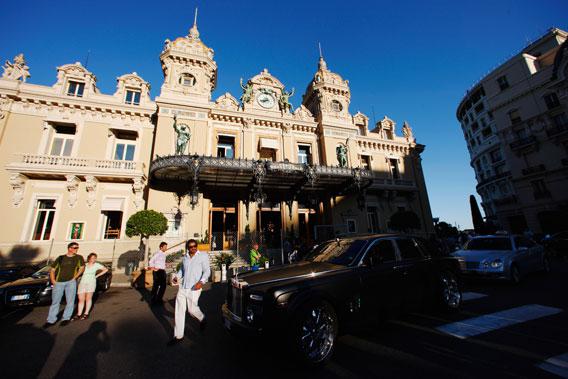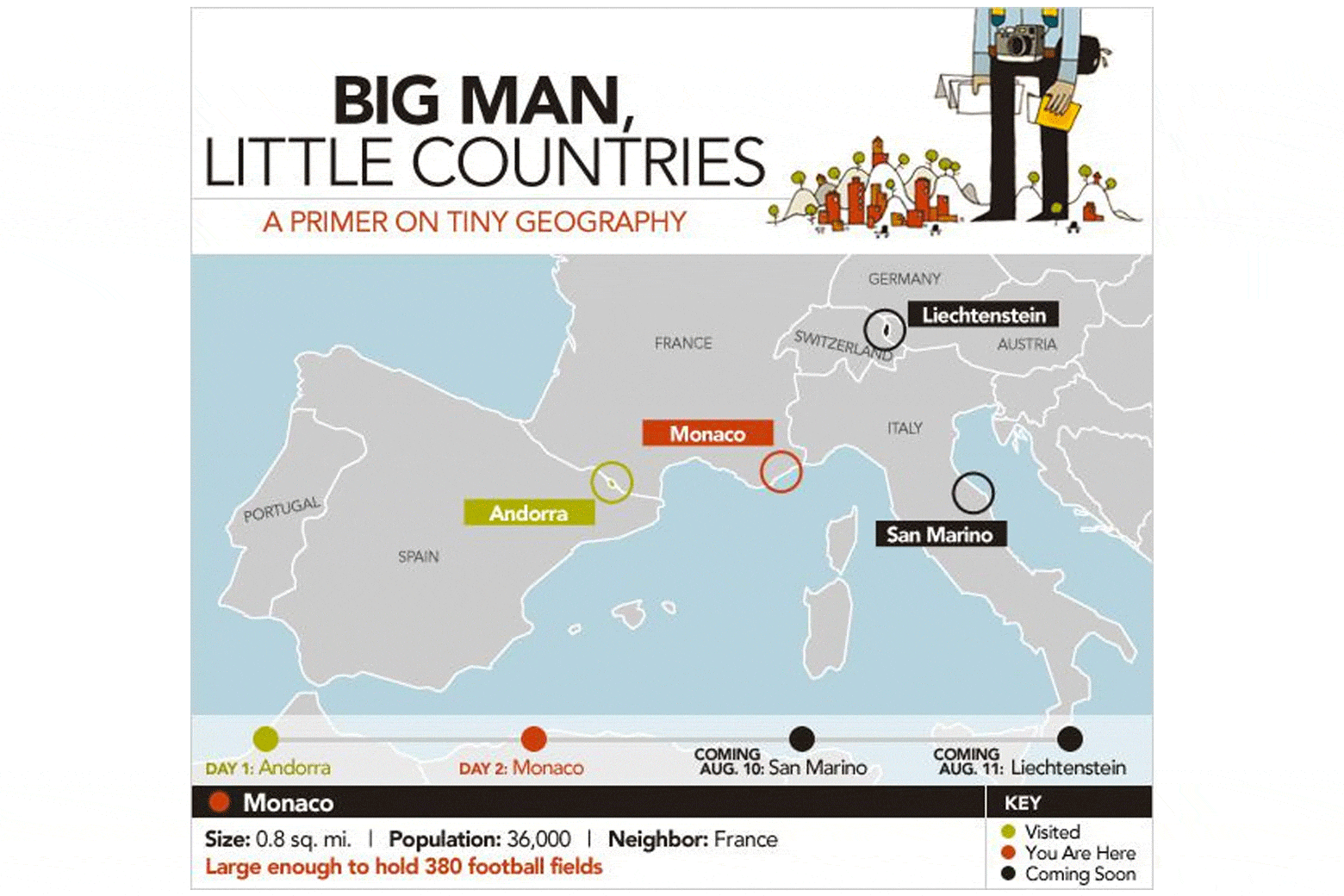In Part 1 of “Big Man, Little Countries,” Josh Levin visits the smuggler’s paradise of Andorra. In Part 3, he goes to San Marino, the world’s oldest republic. In Part 4, he journeys to Liechtenstein for the Games of the Small States of Europe. In Part 5, he attends a tiny-country farewell party.
Leaving a small country isn’t as easy as you’d think. There are no train stations in Andorra, and the buses—to Barcelona, Toulouse, and Girona—appear to operate on smugglers’ hours. Rather than hop on a coach at 5 a.m., we suck it up and spend $65 each on a taxi to the French village of La Tour de Carol. From there, we can head toward our next stop, Monaco, on Le Petit Train Jaune—France’s century-old “little yellow train.” Génial! Terrific, at least, until a lady in the Andorran tourist office tells us the little train has been shut down—we’ll have to backtrack to Spain and get a train from there. Catastrophe!
In the throes of this transportation crisis, we ring up some French friends for advice. They come back with puzzling news: The little train is running fine. Maybe the Andorrans made an innocent mistake, or perhaps they were scheming to keep us in the country until we bought our weight in cigars. Either way, we have learned another important small-country lesson. Don’t ask a legless man for advice on pants, and don’t seek out train tips in a country with no railroad.
And so we leave Andorra by car, rolling past the last of the shopping megaplexes before we hit a bunch of empty chairs at border control. The absence of immigration officials, which would have been quite agreeable if we’d been smuggling out pallets of Marlboros, is frustrating for my traveling companion, the lady photographer, who’s overcome by the primal urge to get her passport stamped whenever and wherever possible. Andorra is not part of Europe’s Schengen Area, a group of 25 countries that functions as a single bloc when it comes to border control. Nevertheless, it’s unclear what you have to do to get your papers examined here. The day before, the transportation-ignorant woman in the tourist office told us that—contrary to Internet wisdom—she couldn’t issue a souvenir stamp. Now, given the whole train situation, I wonder if she was lying—who knows, maybe you get a complimentary passport stamp with each two-liter purchase of duty-free cologne.

The taxi ferries us onward, and Andorra fades into the background as we corkscrew through a beautiful, switchback-laden mountain road—a final reminder of the little country’s stunning landscape. In mid-morning, we connect to Le Petit Train Jaune. What the little train lacks in velocity—the top speed is 34 miles per hour—it makes up for in quaintness. The route through the French Pyrenees is overstuffed with tunnels and bridges and monumental peaks, and we watch the scenery roll by from an open platform at the back of our train car. As we look down at the valleys far below, I’m filled with an enchanting terror.
We stop for a night in the French university town of Montpellier and set out for Monaco the next afternoon. We arrive just in time for the Grand Prix, the Formula 1 auto race that doubles as one of the premier events on the international popped-collar circuit. At 0.8 square miles and with a population of 36,000, Monaco is less a country than a sovereign yacht club. The Grand Prix is the club social, an event that combines the sporty pomp of the Super Bowl, the public drunkenness of Mardi Gras, and the posh ostentation of a debutante ball. A warning to future travelers: If you’re not the kind of person who regularly charters helicopters, race day in Monaco will turn you into a raging, sunburned socialist.

The Monaco Grand Prix is an exercise in coveting thy neighbor’s vantage point. On the outside of this nesting doll of privilege are the people cadging a free look, enterprising skinflints who peek through the temporary metal barricades that line the hillside high above the track. Just below the freeloaders are the standing-room folks, who’ve paid $100 for obstructed views of the distant race course. The standing-roomers gaze at the fans with $750 track-abutting grandstand tickets, and the grandstanders’ eyes wander up to the upper-crusty types in private balconies. Looking down from the balconies, you can see the Paddock Club, where for somewhere in the neighborhood of $5,500 one can enjoy “the generous benefits of gourmet cuisine, an open bar, exclusive entertainment,” and a “privileged view of the start/finish straight.” And who could these boat-shoe-wearing, privileged-view-having aristocrats possibly envy? At the dead center of this vroom-vroom universe, I imagine, is a solitary yacht floating in Monaco’s crystalline water, wherein a fat prince lazily licks foie gras off the Hope diamond.
The lady photographer, always a woman of the people, spends the day snapping pictures among the standing-roomers. Thanks to my press credential, I’m able to glimpse the inner sanctum of the private hospitality pavilions, sponsored by the likes of Red Bull and Pirelli. A few feet away from these pop-up VIP rooms, a pack of red-faced strivers in Ferrari gear press their faces against a fence, hoping to spot a driver or a movie star. This year, with the race not coinciding with the Cannes Film Festival, the celebrity contingent is less Oscar night than Celebrity Apprentice. In an hour of loitering, I spot fair-haired billionaire Richard Branson, Spice Girl Geri Halliwell, and Pussycat Doll Nicole Scherzinger. (The last, who’s better-known in these circles as the love interest of British F1 star Lewis Hamilton, is aggressively catcalled by the Riviera equivalent of construction workers—the trackside representatives of the Automobile Club de Monaco.)
The Monaco Grand Prix also involves, somewhat tangentially, an auto race. I’ve never understood why people like to watch cars go around and around, and seeing a race in person doesn’t turn me into a gear head. From the press box, we can only see one corner of the two-mile-long course. While it requires great skill to maneuver around Monaco’s notoriously tight track—a driver once compared navigating the circuit to “riding a bicycle around your living room“—that tightness also makes passing impossible. (If someone does try to pass, there’s inevitably a crash.) Each lap brings the same routine: The cars zoom by, disappear for one minute and 20 seconds, then reappear in the exact same order. In the media center, nobody bothers to look out the window—we all just follow along on television. In the crowd, too, fans who’ve paid a bundle to “watch the race” actually watch on rented handheld televisions.
Hearing the cars is less of a challenge. The engine noise is deafening and ceaseless. Sound waves bounce off of Monaco’s overstuffed skyline, forming a cochlea-mashing cloud of loudness. The press box provides some insulation, but the windows still rattle unsteadily each time the cars drive past. This makes it all the more impressive that there’s a woman in the media center resting her head on a desk, asleep.
Sebastian Vettel eventually takes the checkered flag due to a strategic gambit that has something to do with tire firmness. The lady photographer lingers in the standing-room section, too far away to realize the show is over—the racing equivalent of the soldier who’s found in the jungle 30 years after World War II.
After shaking off our shell shock, we change into cocktail attire and set out for the Casino de Monte Carlo. Monaco and gambling are longstanding symbionts. Proceeds from the roulette wheel have allowed the tiny principality to maintain its independence, while Monaco has given gambling a veneer of sophistication—the image of 007 playing baccarat in a tuxedo looms larger in the popular imagination than that of the retiree with an oxygen tank pouring her pension check into a one-armed bandit. Monaco’s economy has diversified since the first casino opened here in the 1850s, largely thanks to the efforts of Prince Rainier III—when Rainier died in 2005, it was reported that gambling revenue represented 3 percent of state income, down from 95 percent in the early 1900s. Still, the green felt long ago defined the country’s character. The gush of gaming revenues allowed Prince Charles III to cancel the state’s personal income tax in 1869. A century and a half later, the state’s laissez-faire policies continue to lure the world’s most cosmopolitan tax evaders.

At night, the glowing, filigreed casino looks like a suitable clubhouse for European fancypantses. We go inside, crane our necks at the chandeliers and the tasteful paintings of naked ladies, and walk onto the gaming floor. The place is totally dead: Nobody’s throwing dice, the roulette balls aren’t bouncing, and the roped-off area for big spenders has zero percent occupancy. In the betting palace’s biggest room, there’s action at a single table, where four non-Bonds are playing blackjack for medium stakes. The only other gamblers are way off in the back, lined up in front of less-than-museum-grade slots labeled Coyote Moon, Jackpot Jungle, and Stone Age Cash.
Where have all the rich people gone? A tuxedoed maître d’ tells me people were throwing chips around the previous night, Grand Prix Eve. But the tables aren’t empty simply due to a lack of demand: There’s no roulette, he explains, because the croupiers are on strike. How European.
With Monte Carlo’s high rollers not in evidence, the casino feels like a zoo with no animals. The few people who are here want to watch rather than participate. A few minutes after we get there, a nattily dressed couple walks in—the guy’s wearing a tux, and the woman’s in a long evening gown. They pace the perimeter of the room, arm in arm, looking like they’re on a quest to find the Casino Royale set. Instead, they promenade past a dude in a white T-shirt and shades: no jacket, no tie, no problem. Some movie this is.

Most everyone in Monaco, including us, is playing dress-up. Events like the Grand Prix attract their share of celebrities, hedge fund managers, and Brits with hyphenated surnames. It’s just as important for the country’s coffers, though, to lure visitors who want to put on airs for a weekend. To ensure that the jewel of the Riviera looks the part of a fairy-tale kingdom, every facet of Monaco’s image is polished to a blinding sheen. The public gardens are perfectly manicured, the daily changing of the guard ceremony is terrifying in its precision, and the country’s new princess, Charlene Wittstock, looks less like a human female than lab-grown minor royalty.
This aggressive stage-managing succeeds only if you buy what Monaco is selling. When you’re standing in an empty casino, the entire country feels counterfeit. When you’re inside the velvet rope at the Grand Prix, Monaco is glamorous, opulent, loud, and superficial. That’s exactly what it wants to be.